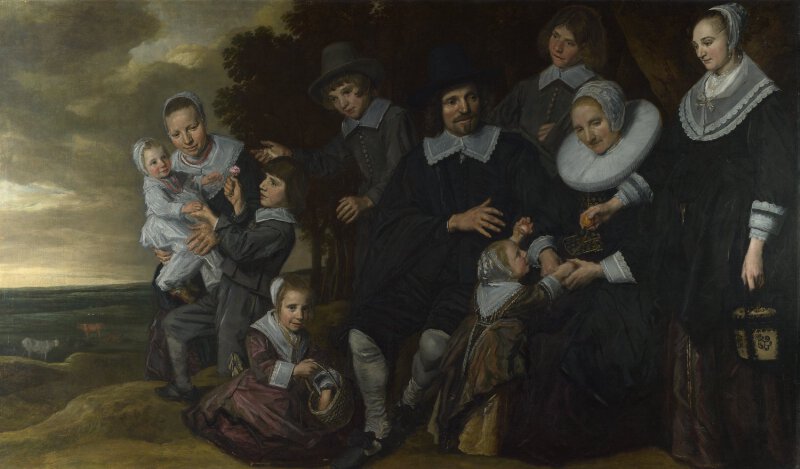Oct. 13, 2018-Jan. 6, 2019
Royal Museums of Fine Arts of Belgium
Feb. 2-April 28, 2019
Collection Frits Lugt in Paris
(dates are to be determined)
In 2011 the Toledo Museum of Art (TMA) added a remarkable Old Master painting to its magnificent collection –
Frans Hals (Dutch, 1582/83–1666), The Van Campen Family in a Landscape (fragment), ca. 1623–25, oil on canvas. 151 x 163.6 cm. Toledo Museum of Art, Toledo, Ohio, inv. 2011.80
Van Campen Family Portrait in a Landscape (circa 1623-25) by Frans Hals.

Frans Hals (Dutch, 1582/83–1666), Children of the Van Campen Family with a Goat-Cart (fragment), ca. 1623–25, oil on canvas. 152 x 107.5 cm. Frans Hals (Dutch, 1582/83–1666), Royal Museums of Fine Arts of Belgium,
Brussels, inv. 4732. ©Royal Museums of Fine Arts of Belgium, Brussels
This acquisition, and the subsequent conservation of Hals’s Children of the Van Campen Family with a Goat-Cart by the Royal Museums of Fine Arts of Belgium (RMFAB) in Brussels, has led the two museums to collaborate on an historic exhibition. Bolstered by evidence from the conservation treatment on the latter painting, scholars verified that the canvases now in Toledo and Brussels, as well as a third in a private collection, once formed a single composition painted by Hals in the early 1620s. The original canvas was cut into sections more than two centuries ago. These spirited representations of the Van Campen family will now be reunited as a result of this significant international partnership. In addition, the four other family portraits painted by Hals, including his only double portrait of a married couple, will be brought together for the first time.
Frans Hals Portraits: A Family Reunion
premieres at TMA, the exclusive U.S. venue, where it will be on view
Oct. 13, 2018-Jan. 6, 2019, before traveling to the RMFAB in Brussels,
Feb. 2-April 28, 2019, and the Collection Frits Lugt in Paris (dates are
to be determined).
“Featuring Frans Hals’s dynamic and authentic imagery of real families,
this exhibition operates on a number of exciting levels, including the
jigsaw puzzle of innovative scholarship, along with the incorporation of
contemporary Toledo-area faces and voices as they consider the
character of family relationships in our community today,” said Brian Kennedy, TMA’s Edward Drummond and Florence Scott Libbey director.
This extraordinary exhibition will spotlight major loans from several
European and North American museums and private collections, including
the Royal Museums of Fine Arts of Belgium in Brussels, Museo
Thyssen-Bornemisza in Madrid, National Gallery in London, Rijksmuseum in
Amsterdam, Cincinnati Art Museum and Taft Museum of Art in Cincinnati
and the Toledo Museum of Art.
The exhibition was co-curated by Lawrence W. Nichols, TMA’s William
Hutton senior curator, European and American painting and sculpture
before 1900, and the RMFAB’s Liesbeth De Belie, curator of 17th-century
Dutch paintings.
One of the greatest portraitists in the history of Western European
painting, Frans Hals (1582/83-1666) is renowned for his revolutionary
candid style of capturing sitters in seemingly spontaneous poses and
lively gestures. A contemporary of Hals’s wrote that his “paintings are
imbued with such force and vitality that…they seem to breathe and live.”


Accompanying the reunion of the Toledo and Brussels portraits in the installation will be Head of a Boy (circa 1623-25) from a private collection, which completes the original painting of the Van Campen family;
Family Group in a Landscape (circa 1645-48) from the Museo Thyssen-Bornemisza, Madrid;

Family Group in a Landscape (circa 1647-50) from the National Gallery in London;


Frans Hals (Dutch, 1582/83–1666), Family Group in a Landscape, ca. 1645–48, oil on canvas. 202 x 285 cm. Museo Thyssen-Bornemisza, Madrid, inv. 1934.8. ©Museo Thyssen-Bornemisza, Madrid
Family Group in a Landscape (circa 1645-48) from the Museo Thyssen-Bornemisza, Madrid;
Family Group in a Landscape (circa 1647-50) from the National Gallery in London;

Marriage Portrait of Isaac Massa and Beatrix van der Laen (circa 1622) from the Rijksmuseum, Amsterdam;Frans Hals (Dutch, 1582/83–1666),Marriage Portrait of Isaac Massa and Beatrix van der Laen, ca. 1622, oil on canvas.140 x 166.5 cm. Rijksmuseum, Amsterdam, inv. SK-A-133.©Rijksmuseum, Amsterdam

and Portrait of a Dutch Family (mid-1630s) from the Cincinnati Art Museum.Frans Hals (Dutch, 1582/83–1666), Portrait of a Dutch Family, mid-1630s, oil on canvas. 111.8 x 89.9 cm. Cincinnati ArtMuseum, Cincinnati (Ohio), inv. 1927.399
Setting the scene and providing context for the exhibition will be a
gallery of other works of Netherlandish art from TMA’s collection that
represent families. Leading into the exhibition of portraits by Hals
will be an entry space devoted to encouraging visitors to reflect on
multiple definitions of family by engaging with a selection of TMA
objects across cultures and eras, as well as a monumental collage and
video of Toledo community members, which resonate with the theme of
family.
Upon exiting the focused Hals section, visitors will be invited to
respond to the portraits on view by sharing their own perspectives of
family in the 21st century through a series of interactive tools and
approaches. In addition, a library and reading area and performance
space will be provided to further enhance the gallery experience.
“As one of the leading luminaries of the Dutch Golden Age, Hals is also
one of the most ingenious and accessible artists of any period or
place,” said Nichols. “His charismatic and sympathetic portraiture not
only reflects 17th-century everyday life, it also provides us with a
rich platform from which to explore and approach the meaning of family
in our own time.”
Family portraiture first emerged in the Netherlands as a genre in the
early 16th century, when prosperous middle-class Dutch families began to
commission artists for their likenesses. These family portraits would
have been displayed in private homes, not public exhibition spaces,
though in spaces in the house where guests would see them. Most of these
group portraits featured families in a domestic interior or a parkland
setting. The major challenge for artists working in the genre was how to
represent individuality as well as the collective dynamic.

